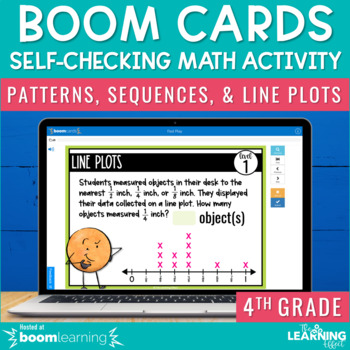Patterns Sequences Line Plots Boom Cards | 4th Grade Math Test Prep Activity
- PDF
- Internet Activities
Description
Use these self-checking, no-prep Boom Cards™ to review 4th grade Patterns, Sequences, and Line Plots math skills. This resource covers 4th grade math skills, including line plots, numeric patterns, nonnumeric patterns, rules, and equations. This fun and interactive way to review is great for distance learning, homework, independent work, or whole class on an interactive whiteboard!
The questions used in this resource are also available in these formats:
THIS RESOURCE INCLUDES
» 26 self-checking digital task cards hosted on Boom Learning℠
» 5 game categories with 5 questions each:
- Line Plots
- Numeric Patterns
- Nonnumeric Patterns
- Rules
- Equations
» Final challenge question
FILE FORMAT
- PDF: This resource requires Adobe Reader (free software) to access and is NOT editable in any way. You will not be able to manipulate the content inside.
- Boom Cards™: To use Boom Cards™, you must be connected to the Internet. Boom Cards™ play on modern browsers (Chrome, Safari, Firefox, and Edge). Apps are available for Android, iPads, iPhones, and Kindle Fires. For security and privacy, adults must have a Boom Learning℠ account to use and assign Boom Cards™. You will be able to assign the Boom Cards™ you are buying with "Fast Pins" (play provides instant feedback for self-grading Boom Cards™). Fast Play is always a free way for students to engage with Boom Cards™ decks. For additional assignment options, you'll need a premium account. If you are new to Boom Learning℠, you will be offered a free trial of their premium account.
• • • • • • • • • • • • • • • • • • • • • • • • • • • • • • • • • • • • • • • • • • • • • • • • • • • • • • • • • • • • • • • • • • • • • •
4th Grade Math Resources
✮ Metric Measurement Game Show | 4th Grade
✮ Customary Measurement Game Show | 4th Grade
✮ Area and Perimeter Game Show | 4th Grade
• • • • • • • • • • • • • • • • • • • • • • • • • • • • • • • • • • • • • • • • • • • • • • • • • • • • • • • • • • • • • • • • • • • • • •
CLICK HERE to follow The Learning Effect and be the first to know when new resources are added to my store! New resources are always 50% off for the first 48 hours they are posted.
Connect With Me: The Learning Effect Blog • Instagram • Pinterest • Facebook
Please ask ANY and ALL questions before purchasing.
Thank you so much!
Tiffany Schmidt
The Learning Effect
Copyright © Tiffany Schmidt
All rights reserved by author.
Permission to copy for single classroom use only. If using with multiple classrooms, please purchase additional licenses at a discounted rate.





